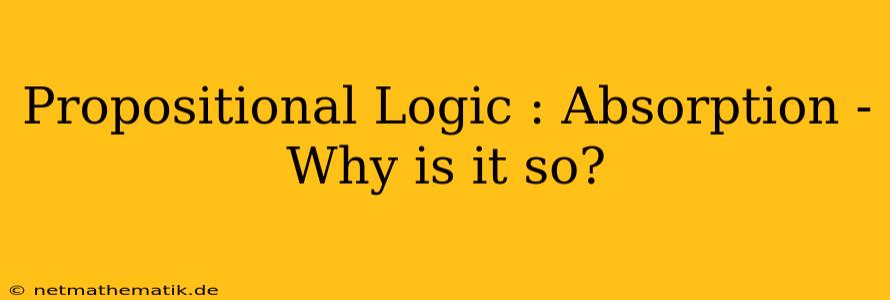Propositional Logic: Absorption - Why is it so?
In the realm of propositional logic, where statements are expressed through logical connectives, certain laws govern the relationships between these statements. One such fundamental law is the Absorption Law, which states that in a conjunction, a proposition can be "absorbed" by a disjunction containing itself. This might seem counterintuitive at first glance, but a closer examination reveals the elegance and practicality of this principle.
Let's delve into the core of the absorption law and explore why it holds true.
Understanding the Absorption Law
The Absorption Law, formally expressed as:
P ∧ (P ∨ Q) ≡ P and P ∨ (P ∧ Q) ≡ P
Essentially states that if a proposition P is conjoined with a disjunction of itself (P) and another proposition (Q), the resulting expression is logically equivalent to P itself. Similarly, the same principle applies when P is disjoined with a conjunction of itself (P) and another proposition (Q).
Truth Tables: A Visual Proof
One way to understand the truth of the Absorption Law is by examining truth tables.
Let's consider the first form of the absorption law: P ∧ (P ∨ Q) ≡ P. We can construct a truth table for both sides of the equivalence:
| P | Q | P ∨ Q | P ∧ (P ∨ Q) | P |
|---|---|---|---|---|
| T | T | T | T | T |
| T | F | T | T | T |
| F | T | T | F | F |
| F | F | F | F | F |
As we can see from the truth table, the columns for P ∧ (P ∨ Q) and P are identical. This demonstrates that regardless of the truth values of P and Q, both expressions result in the same truth value. Therefore, the two expressions are logically equivalent.
The Intuition Behind Absorption
To grasp the intuition behind the Absorption Law, let's consider a real-world example. Imagine you are at a party, and you are told that you can have either a pizza or a sandwich (P ∨ Q). However, you are also told that you can only have pizza (P). In this scenario, your options are limited to only having pizza, as the sandwich option becomes irrelevant. This effectively means that P ∧ (P ∨ Q) is equivalent to P.
Applications of the Absorption Law
The Absorption Law is a valuable tool in propositional logic and its applications, particularly in:
- Simplifying Logical Expressions: The law allows for the simplification of complex expressions by eliminating redundant components. This is crucial in building efficient and understandable logical circuits and proofs.
- Boolean Algebra: In the realm of boolean algebra, which is used to represent and manipulate logic circuits, the Absorption Law plays a key role in simplifying circuit design and minimizing component usage.
- Deductive Reasoning: The law serves as a fundamental rule of inference, allowing us to derive new conclusions from existing premises. It provides a basis for deductive arguments and proofs.
Conclusion: The Power of Absorption
The Absorption Law is a powerful tool in propositional logic that simplifies expressions, provides intuition, and aids in deductive reasoning. Its application across various fields highlights the importance of understanding its core principles. By embracing this law, we gain a deeper understanding of how logic operates and how it can be effectively used to solve problems and derive meaningful insights.
